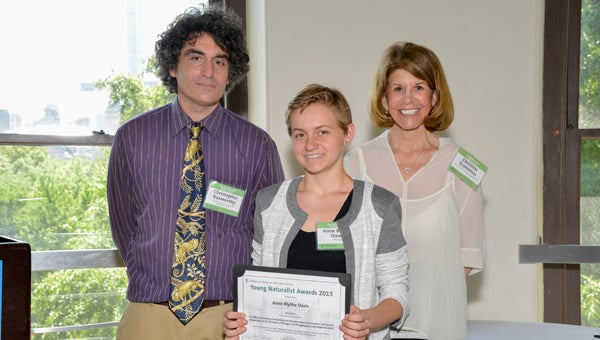Hyde County student wins AMNH award
Published 8:31 pm Wednesday, June 10, 2015

D. FININ | AMERICAN MUSEUM OF NATURAL HISTORY
Local student Anne Blythe Davis (pictured middle) was one of 12 students in the country to receive the 2015 Young Naturalist Award from the American Museum of Natural History. Presenting the award certificate were (pictured from left) Christopher Raxworthy, associate curator in the Department of Herpetology and associate dean of Science for Education and Exhibitions, and Christine Economos, senior program administrator for the award.
SWAN QUARTER — A Hyde County high-school student recently won an award for science-based research.
Anne Blythe Davis, a high-school junior from Swan Quarter, was one of 12 winners announced by the American Museum of Natural History for its 18th annual Young Naturalist Awards, a nationwide science-based research and essay competition for students in grades seven through 12 that focuses on the natural world. The competition encourages research in Earth science, ecology, astronomy and biology and is part of the museum’s effort to focus on authentic science experience, according to Michael Walker, manager of media relations at the museum.
The science competition is the only one in the nation that does so as part of a bigger initiative to focus on authentic science experiences that increase student participation in science, technology, engineering and mathematics (STEM) fields.
Davis, a student of Stanford University Online High School, entered the competition, citing her work since eighth grade investigating how increasing nitrogen and phosphorous paired as well as individually affect phytoplankton concentration and species composition in Lake Mattamuskeet, a refuge in Hyde County, she said. She collected 180 one-liter containers filled with lake water during peak phytoplankton concentrations and introduced various levels of nitrogen, phosphorous, nitrogen and phosphorous and Instant Ocean sea salts. After, she incubated the containers in floating corrals in a canal near the lake, hypothesizing that nitrogen-dosed samples would have higher concentrations of chlorophyll than the phosphorous or control samples, Davis said. She also guessed that samples with both elements would have significantly higher amounts than the rest of her samples, Davis said.
After her research, Davis found both to be true, but a hypothesis that the addition of the sea salt would lead to decreased chlorophyll was proved wrong.
Davis said she did the research because her family was part of the farming community in Hyde County that contributes to increased nutrient levels in the lake. With the survival and thriving of wildlife species, as well as Hyde County’s tourism sector, depending on the water quality of the lake, Davis wanted to find ways of improving its water quality, she said.
“On a more personal level, I was driven to conduct this research because my family’s livelihood is farming and our farm contributes to the nutrient load in the lake. I designed my project to answer questions that would lead to improving the water quality of Lake Mattamuskeet and water bodies throughout the world — waters that support wildlife, fisheries, and human communities — and are simultaneously impacted by nutrient input and sea level rise. It’s nice to have some sort of awareness raised for issues going on with the lake and recognizing the work I’ve done. It was nice to know that other people thought it was worthwhile.”
As part of winning the award, Davis and the other winners attended a ceremony and banquet in New York and were given a behind-the scenes tour of the museum, Davis said.
The awards program was developed by the museum to promote students’ active observation of the natural world and to give recognition for excellence in biology, ecology Earth science and astronomy, according to Walker. The award is a program of the National Center for Science Literacy, Education and Technology (NCSLET) under the museum’s education department.
“The winners of the Young Naturalist Awards demonstrate a true passion for science research and communication and are exemplars for what young people are capable of,” said Dr. Rosamond Kinzler, senior director for science education and director of NCSLET. “Whether these young students studied the phytoplankton levels in a local lake in North Carolina or investigated scavengers on the Serengeti in Kenya, their essays reveal the same dedication to the practice of science as our Museum scientists demonstrate. The Museum is committed to inspiring and supporting young people like this year’s winners in their quest to use the scientific process to learn more about the world around them.”
According to Walker, the museum will also present the Theodore Roosevelt Memorial Award to the student whose investigation demonstrates close observation, thoughtful analysis, and deep appreciation of the biodiversity, ecology and habitats found in an urban environment. The winning essay was selected from the pool of Young Naturalist Awards entrants and was evaluated according to the same criteria.
This year’s winners, including students from California, Connecticut, Florida, Georgia, Maryland, Michigan, Minnesota, Missouri, New York, and North Carolina, were recognized at an all-day event at the Museum, which included a behind-the-scenes tour, an awards ceremony, and a luncheon. Winners also received cash awards ranging from $500 to $2,500, according to Walker.
Davis said after high school, she would like to go into the chemistry or math fields and continue similar science research.





